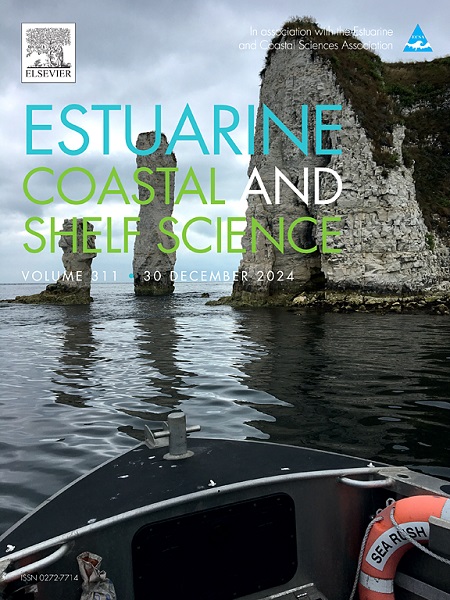一种新的控制体积方法来限制潮汐淡水河流内生态系统养分循环
IF 2.6
3区 地球科学
Q1 MARINE & FRESHWATER BIOLOGY
引用次数: 0
摘要
潮汐淡水系统是动态的生物地球化学热点,在养分循环和流域衍生物质的衰减中起着至关重要的作用。传统的生物地球化学分析通常依赖于基于有限数据集的插值、回归和遥感等估计技术,这可能导致显著的不确定性。本研究将一种新颖的采样方法应用于位于澳大利亚新南威尔士州远东北海岸的潮汐淡水系统,通过将高分辨率离散时间序列和流体动力学测量与传统底栖生物通量方法相结合,量化“控制体积”(CV)内的营养通量。研究发现,高NH4消耗和高NOx产量反映了好氧水柱内的硝化作用。控制体积内的总需氧量与沉积物需氧量和硝化需氧量的总和非常接近,突出了TFZ内沉积物生物地球化学过程的重要性。对照体积NOx消耗和P释放量比传统沉积物核心孵育得到的数据大几个数量级,这表明里士满河TFZ中的NOx和P动力学是由沉积物动力学和/或低估原位通量的沉积物孵育以外的过程驱动的。新的控制体积方法提供了一种高分辨率的采样技术,较少的采样人工制品,并增强了对潮汐和死亡循环的生物地球化学趋势的理解。通过将生物地球化学测量与水动力过程相结合,该方法有效地将营养循环限制在一定范围内,从而提供了测量期间营养过程的详细信息。本文章由计算机程序翻译,如有差异,请以英文原文为准。

A novel control volume methodology to constrain ecosystem nutrient cycling within a tidal freshwater river
Tidal freshwater systems are dynamic biogeochemical hotspots that play a crucial role in nutrient cycling and the attenuation of catchment derived material. Traditional biogeochemical analysis typically relies on estimation techniques such as interpolation, regression, and remote sensing based on limited data sets, which can result in significant uncertainties. This study applies a novel sampling approach to a tidal freshwater system located on the far northeast coast of New South Wales, Australia, to quantify nutrient fluxes within a “control volume” (CV) by combining high-resolution discrete time series and hydrodynamic measurements in combination with a traditional benthic flux methodology. The study found high NH4 consumption and high NOx production reflective of nitrification within the aerobic water column. The total oxygen demand within the control volume was very close to the aggregate of the sediment oxygen demand and nitrification oxygen demand, highlighting the importance of sediment biogeochemical processes within the TFZ. Control volume NOx consumption and P release were orders of magnitude larger than those obtained from traditional sediment core incubations, suggesting that NOx and P dynamics in the Richmond River TFZ are driven by processes other than sediment dynamics and/or sediment incubations underestimated in situ fluxes.
The novel control volume methodology offers a high-resolution sampling technique with fewer sampling artifacts and an enhanced understanding of biogeochemical trends over the tidal and diel cycles. By integrating biogeochemical measurements with hydrodynamic processes, this method effectively constrain nutrient cycling within a defined reach, providing detailed insights into nutrient processing during the measurement period.
求助全文
通过发布文献求助,成功后即可免费获取论文全文。
去求助
来源期刊
CiteScore
5.60
自引率
7.10%
发文量
374
审稿时长
9 months
期刊介绍:
Estuarine, Coastal and Shelf Science is an international multidisciplinary journal devoted to the analysis of saline water phenomena ranging from the outer edge of the continental shelf to the upper limits of the tidal zone. The journal provides a unique forum, unifying the multidisciplinary approaches to the study of the oceanography of estuaries, coastal zones, and continental shelf seas. It features original research papers, review papers and short communications treating such disciplines as zoology, botany, geology, sedimentology, physical oceanography.

 求助内容:
求助内容: 应助结果提醒方式:
应助结果提醒方式:


